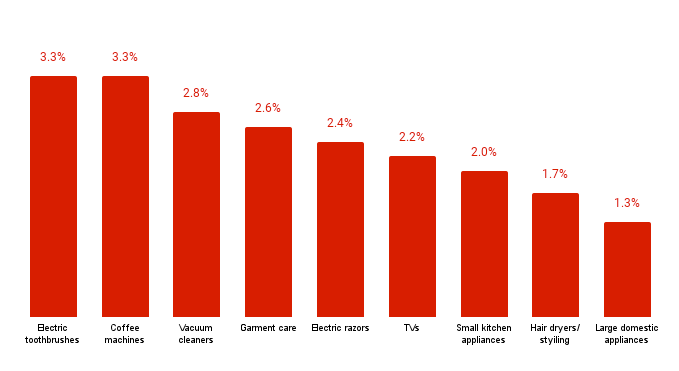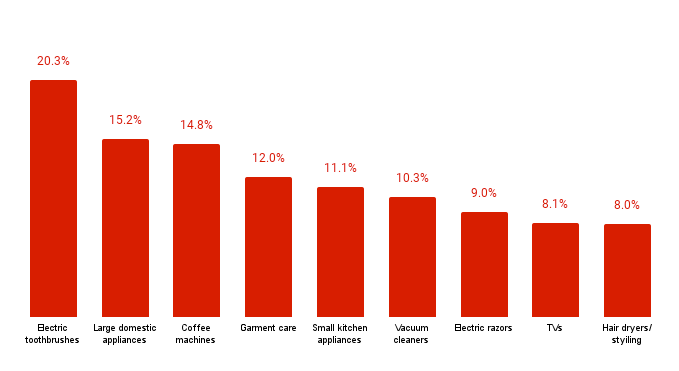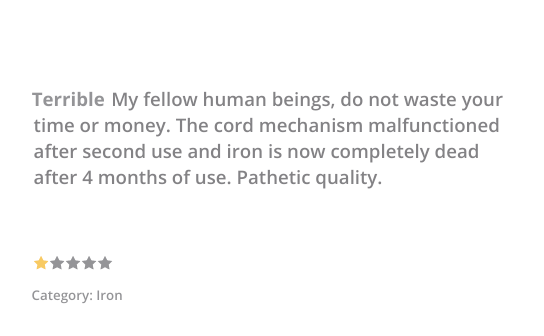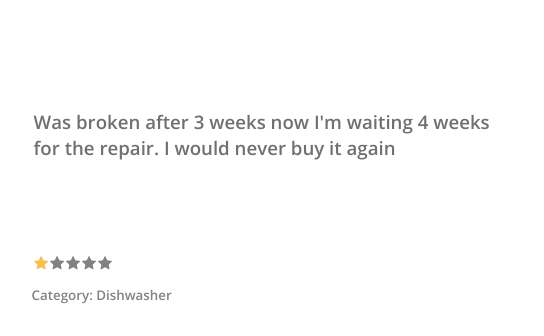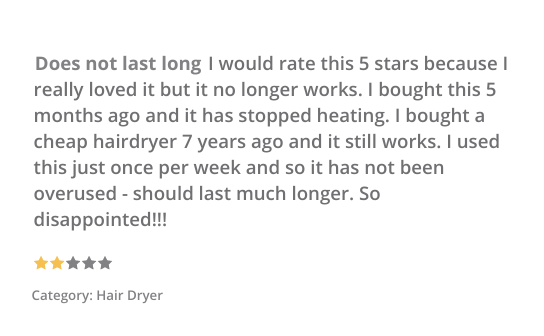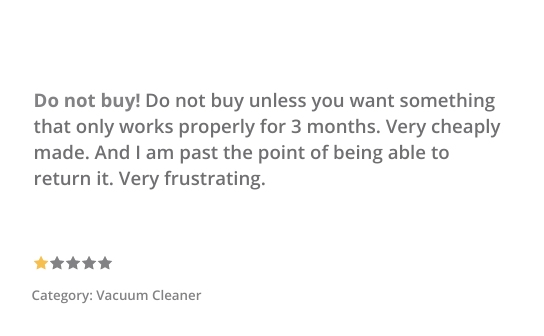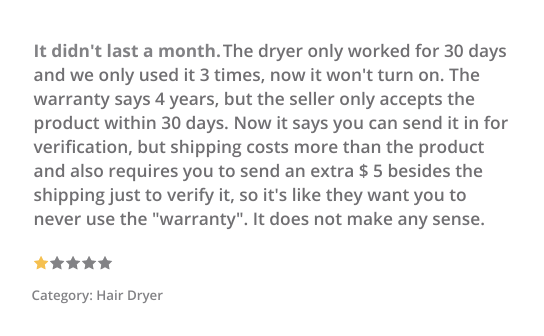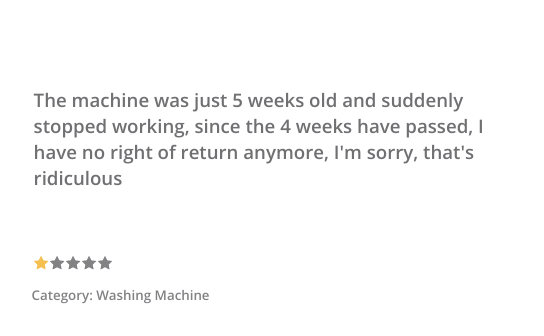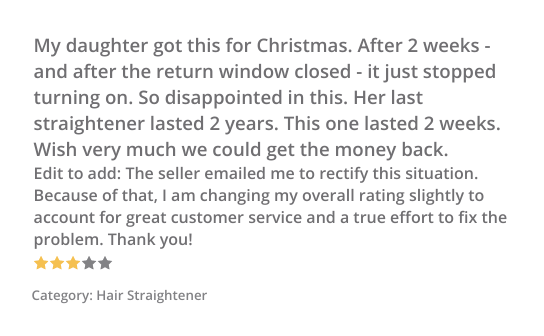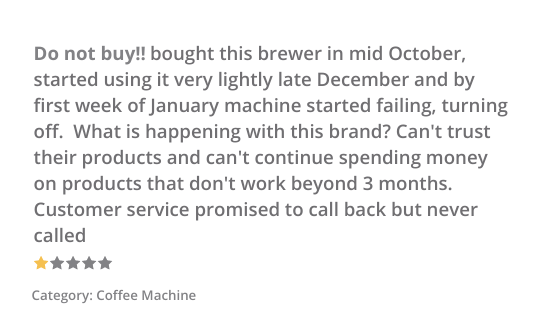Why Does Product Durability Matter So Much In Consumer Electronics
Nothing surely lasts forever, but that shouldn't stop brands from creating high-quality products to fulfill customer expectations. In this blog post we explain the importance of product durability for consumer electronics companies to achieve the best customer experience (CX). We also used examples of the words of real customers.
·8 min read
Lidia Palmi
It might sound very obvious, but when customers purchase a product, they expect it to last. They probably don’t even think about it, as this is something they take for granted.
Though they will decide to stop using this product at some point because either they don’t like it anymore, they desire a newer version, and so on, the customer still expects the product to properly work until they need it.
Of course, the perception of how long a product should last is subjective. For somebody, it might seem acceptable for an electric toothbrush to stop working after some years. In contrast, another person would be very bothered and call Customer Care to request a replacement.
Every product obviously has a warranty period, which indicates the minimum amount of time that product is expected to last. However, that doesn’t necessarily mean that customers will be satisfied if it “only” lasts for that period, and we will see examples of this later on.
Moreover, the expectation of how long a product should last is often driven by the paid price: the lower the price, the lower the customer expectation. Therefore, several factors come into play to define the customer’s expectation regarding a product’s lifespan.
Every customer will probably have different expectations, but there’s one common thing among all customers: when their expectations are unfulfilled their satisfaction drops.
The discussion around the lifespan of products, particularly electronic products, has gained importance in recent years, mainly due to the growing focus on the environment and sustainability, both from consumers and manufacturers. It has become more evident that frequent substitution of products (e.g., smartphones, toasters, TVs) produces a significant and unnecessary amount of waste.
However, the topic of “planned obsolescence” has been under the spotlight for decades. Even the European Union felt the need to introduce laws and regulations around it. For instance, countries like France introduced specific regulations to guarantee the repairability of products for a certain amount of years.
Regardless of whether the “death” of a product is planned or not, consumers are not satisfied when the product they bought suddenly stops working. This is strongly reflected in the ratings and reviews they leave online.
If I want to buy a new coffee machine, I will most likely check what other customers say online about the product I had in mind. Suppose I find other customers complaining about the machine breaking down after a few months. In that case, that will probably deter me from buying and instead push me towards choosing another product. And that’s something that brands don’t want to happen.
Analyzing 9 Popular Consumer Electronics Categories
In the following paragraphs, we analyze how important a product’s durability is across different consumer electronic categories (from small kitchen appliances to hairdryers, to electric razors, to vacuum cleaners). We also look at how much it impacts customer satisfaction and what customers are saying about this aspect.
For this analysis, we have considered nine different categories within the Consumer Electronics scope:
- Garment Care
- Electric Razors
- Electric Toothbrushes
- Coffee Machines
- Small Kitchen Appliances
- Hair Dryers and Hair Styling Devices
- Vacuum Cleaners
- Large Domestic Appliances
- Televisions
Considering these nine categories altogether, we have analyzed approximatelytwo million ratings and reviews. They’re sourced from dozens of eCommerce platforms (Amazon, Walmart, and Mediamarkt, just to name a few) and across several European and American countries.
Given the nature of the topic analyzed - the Durability of a product - it’s important to highlight that most of the comments related to this aspect are negative comments.
As said, customers usually expect their products to work, and they are likely to comment on a product that has stopped working rather than highlighting that a product is still working for a certain amount of time post-purchase. So for this analysis, we will mainly focus on negative reviews around Durability.
Product Durability in Consumer Electronics
Across the analyzed categories, we see that Durability is one of the topics that customers talk the most negatively about. The topic is also one of the aspects with the highest impact on low ratings ( i.e., low customer satisfaction).
Regarding the frequency with which the topic is negatively mentioned across the analyzed reviews, we see specific differences across these categories, with percentages ranging from 1,3% to 3,3%. You can also view this from the graph below.
Chart 1: Percentage of negative reviews about Durability over total reviews
These might seem like small numbers. Still, we have to consider that we are looking at the total number of existing reviews for each category, where the majority of reviews are actually positive ones and don’t contain any complaints on any aspect.
In fact, these numbers get much higher if we only look at products with a rating of 1 or 2 stars, with percentages of negative comments about durability that go up to 20% for Oral Care products. This is shown in the second chart below.
Chart 2: Percentage of negative reviews about Durability among 1 and 2-star ratings
On average, more than 1 in 10 customers who rated their product with 1 or 2 stars are complaining about Durability across the analyzed categories.
We shall further consider that these figures probably underestimate the reality since not all consumers are likely to write a review or update an existing review written six months or one year prior. If a product breaks down, some customers might just contact customer service to ask for a replacement or a refund. Yet, they would not necessarily return to update their review months after they’ve written it (and it might have initially been a positive review). However, many of them do so, as we can see from the examples below:
Example 1
Example 2
Example 3
The Impact of Product Durability on Customer Satisfaction
Besides the frequency with which customers talk about Durability, another significant metric we looked at is the relevance of this topic. The relevance measures the impact that a topic has on the average rating, both positively and negatively. This means, in our case, we can see Durability’s contribution to low customer satisfaction.
Across the nine analyzed categories, for six of them, Durability is the number one or number two driver of low satisfaction, together with specific functional issues that the different devices and products might have.
Regardless of the number of people complaining about a product’s Durability, this metric clearly tells us that when a product stops working before expected, it has a strong and direct impact on customer satisfaction, being one of the main drivers of low ratings.
There are three categories where Durability ranks slightly lower (in the fourth position): Hair Dryers/ Styling, Electric Razors, and TVs.
For these categories, beyond the negative reviews resulting from functional product issues, other specific aspects seem to have more impact than Durability. For example, for hairdryers/ styling, it’s damages caused to the hair (e.g., burning or ruining the hair). For electric razors, it’s the (poor) cutting performance. For TVs, it’s the (low) quality of the picture and the sound.
The Relation Between Product Durability and the Warranty or Return Period
One more aspect related to the lifespan of consumer electronic products has emerged from customer reviews. It’s the relation between the lifespan itself and the warranty or return period.
Customers get particularly annoyed when a product breaks down shortly after the warranty or return period has expired. They can feel very deceived when that happens (see later examples) as they have the feeling that it’s not just a coincidence. They are ultimately stuck with a broken product and have no other option but to buy a new one.
Some customers openly hint at the fact that the product has been planned to break down after a certain amount of time (hence, planned obsolescence), for example, when a product has a warranty of two years and it suddenly breaks down after two years and one month.
This generates a strong mistrust in the brand. Even those who have been loyal customers of the brand for years might eventually decide to switch to another brand after a bad experience. Here are some detailed examples:
Example 4
Example 5
Example 6
Example 7
In such cases, it becomes more and more evident the importance of post-sales and customer care service. When customers contact a customer service team feeling disappointed and frustrated because the purchased product has died, they need to receive the best possible service.
Solving the customer’s issue and making the process as easy as possible is what makes the difference between keeping or losing that customer. While the experience with the product might be a bad one, having a good experience with customer service might actually be the only way for a brand to keep a customer who would otherwise switch to the competition.
Example 8
Example 9
Conclusion
As we said initially, customers buy products expecting them to last, which is an implicit expectation. Problems arise when that expectation is not fulfilled.
The short lifespan of a product is in fact one of the most impactful aspects in driving the rating of a product down. Despite the importance of this aspect, there are still many customers complaining about it, which indicates that there is still needed improvement for brands to boost their performance on this aspect.
Although, when a customer is unhappy with a product, not everything is yet lost. Brands can still retain that customer through excellent customer service.
So working on two levels, product and customer service, presents a clear opportunity for each business to stand out among their competitors.

